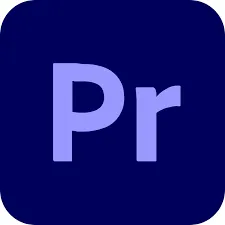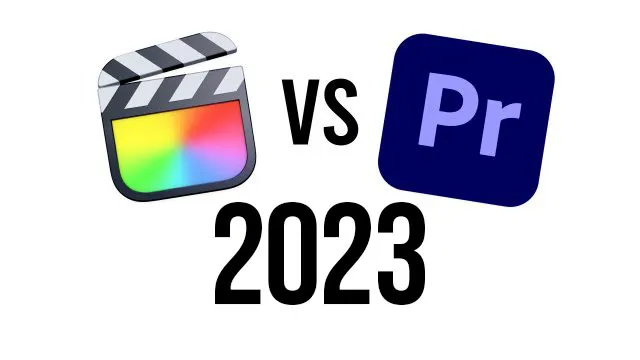I am a video editing veteran that lives in two worlds.
The world of Adobe: using Premiere Pro and After Effects for much of my work.
And the world of Apple: using Final Cut Pro for additional work.
But why?
Let's go over the pros & cons of each of the video editing software suites for 2023.
Table of Contents
- Final Cut Pro History
- Premiere Pro History
- Final Cut Pro Cost
- Premiere Pro Cost
- Is There A Trial Period?
- Which Is Better?
- Final Cut Pro Speed
- Premiere Pro Speed
- Final Cut Pro Plugins
- Premiere Pro Plugins
- Final Cut Pro Ease Of Use
- Premiere Pro Ease Of Use
- Final Cut Pro Professional Features
- Do Professional Video Editors Use Final Cut Pro?
- Premiere Pro Professional Features
- Apple Motion Vs. Adobe After Effects:
- Adobe Audition Vs. Logic Pro:
- Final Cut Pro Color Grading
- Premiere Pro Color Grading
- Final Cut Pro Vs. Premiere Pro: Which Should You Use?
A quick primer:
Apple Final Cut Pro History
Final Cut Pro is a video editing software that was first developed by Macromedia Inc. and later acquired by Apple in 1998.
It was initially released in 1999 as a consumer-level application, but soon became popular among professional editors as well.
In 2003, Apple released Final Cut Pro HD, which added support for high-definition video.
In 2007, they released Final Cut Pro X (FCPX), which completely redesigned the software from the ground up with a new interface and an emphasis on 64-bit performance.
This caused a stir with video editors, who complained that the major Final Cut Pro X update was a step back for professionals.
The user interface completely changed and the addition of the magnetic timeline was a paradigm shift that many video editors were not on board with.

Adobe Premiere Pro History
Premiere Pro is a video editing software that was first developed by Adobe Systems in 2003.
It was initially released as part of Adobe Creative Suite (now Adobe Creative Cloud), and soon became the industry-leading video editing software.
In 2013, Adobe released Premiere Pro CC (Creative Cloud), which added support for new formats and workflows, as well as a host of other features.
In 2017, they released Premiere Pro CC (2017), which included even more new features and improvements.

Final Cut Pro vs Premiere Pro: How much do they cost?
Final Cut Pro Cost:
This is one area where the two video editing software suites differ quite a bit. Final Cut Pro X is available for a one-time purchase of $299.99.
After the one-time purchase, all updates for Final Cut Pro are a free download via the MacOS app store.
The motion graphics application Apple Motion is an additional cost of $49.99, and the encoding application Apple Compressor is an additional cost of $49.99.
If you are an educator or student, there is a discount for Final Cut Pro.
Premiere Pro Cost:
Premiere Pro CC requires a monthly subscription of $20.99/mo. for just Premiere Pro (single plan) or the entire Adobe Creative Cloud suite for around $54.99 per month.
See a deep dive on the Premiere Pro Price and what you get.
The Adobe Creative Cloud suite of applications includes 20+ apps: video apps like Adobe After Effects, Adobe Audition, Media Encoder; and graphics applications like Photoshop and Illustrator.
With the Adobe Creative Cloud monthly subscription cost, all updates are free and Adobe generally releases major updates yearly to its Creative Cloud applications
If you are an educator or student there are discounts for the Adobe Creative Cloud packages.
Cost Winner:
With a one-time cost, forever, $299 is a good deal for a powerful application like Final Cut Pro. For $20 a month for Premiere Pro or $50 a month for the entire Creative Cloud suite, you get a lot of power and a ton of apps for a moderate monthly fee.
I'm going with the Creative Cloud package for best value if you need all of the other applications in your life.
This page may include affiliate links.
Though I only recommend software that I use and fully believe in.
⭐⭐⭐⭐⭐
I pay for Adobe Creative Cloud and have used it every day in my 20-year career as a video editor, producer, and colorist.
Purchasing Adobe CC through these links will get you the best deal available and support this site.
Get Adobe Creative Cloud Now!Final Cut Pro v Adobe Premiere Pro: Is there a trial period?
Adobe offers a free trial of Premiere Pro, which allows you to try the software for seven days. After the trial period is over, you will need to purchase a monthly subscription in order to continue using the software.
There is not a free trial for Final Cut Pro, it is simply a purchase made through the MacOS app store.
OK, let's get into the nitty gritty:
Final Cut Pro vs. Adobe Premiere Pro. Which is better?
As I said at the beginning, I spend a lot of time in both applications and, of course, they both have their strengths and weaknesses.
Let's talk strengths of both applications.

Final Cut Pro vs. Adobe Premiere Pro: Speed
Apple Final Cut Pro Speed
One of the things I love about FCP is how quickly I can edit.
The interface is very intuitive and, once you get used to the magnetic timeline, it's hard to go back to another editing software that doesn't have it.
With the introduction of FCPX, Apple has made a few changes to the way things are done and, in my opinion, they've made editing faster and easier.
Final Cut Pro is made by the people who make the machines it runs on, so it is particularly tuned to run on Mac hardware.
On current Mac machines with M1 / M2 processors, it's crazy fast for editing and encoding video.
Adobe Premiere Pro Speed
Adobe's Premiere Pro is also a very fast video editing software, but it doesn't quite match the speed of FCP.
One of the things that makes Premiere Pro a bit slower is the fact that it relies heavily on your computer's graphics processor (GPU). So, if you don't have a good GPU, Premiere Pro will be slow.
Also, since it is a cross-platform (Mac and Windows) application, it has to work well on both and I'd imagine it's not as tuned for Mac hardware as Final Cut Pro is.
Winner:
If you're using MacOS and a modern Apple Computer, Final Cut Pro wins the speed category.
Final Cut Pro vs. Adobe Premiere Pro: Plugins
Final Cut Pro Plugins
Final Cut Pro comes with a few plugins pre-installed, but there are many more available from third-party developers. You can find plugins for everything from social media sharing to title creation to color correction. There are even some great free ones out there!
I am a huge fan of the FxFactory ecosystem of Final Cut Pro plugins, which is like an app store for visual effects, including a huge variety of plugins. Full disclosure: I create tutorial videos for the FxFactory YouTube channel. BUT I get to see all the plugins firsthand and they are awesome!
Adobe Premiere Pro Plugins
Premiere Pro has a similar situation with plugins. It comes with a few, but there are many more available from Adobe and third-party developers. Like Final Cut Pro, you can find plugins for social media sharing, title creation, and color correction. Most of the best ones cost extra money.
Both applications have a thriving plugin ecosystem and it's one of the things that makes them both so powerful. If you can dream it, chances are there's a plugin that can do it.
Winner:
I think between the plugin ecosystems of Final Cut Pro's and Premiere Pro's, this one might be a toss up, though if you include Adobe After Effects into the mix (you get AE with a Creative Cloud subscription), Premiere Pro would take the advantage. After Effects has a very rich and mature ecosystem of plugins and you can use After Effects sequences right in Premiere Pro.
Final Cut Pro vs. Adobe Premiere Pro: Ease of Use
Apple Final Cut Pro Ease of Use
Is Final Cut Pro good for beginners? Yes!
Final Cut Pro is just so well designed and thought out. Even if you've never edited video before, you can probably figure out how to do basic edits in Final Cut Pro pretty quickly.
Of course, the more you learn about editing, the more you'll be able to take advantage of all the features Final Cut Pro has to offer.
But, even if you're a beginner, I think FCP is the easier application to get started with.
The main thing that split off pro video editors from Final Cut Pro was the trackless magnetic timeline. But for a beginner, this is a great way to edit video.
Adobe Premiere Pro Ease of Use
Premiere Pro is not as easy to use as Final Cut Pro, but it's not that hard either.
I think the biggest learning curve with Premiere Pro is just understanding the interface.
Once you get used to where things are and how things work, it's actually a pretty straightforward application.
It's worth mentioning here that Premiere Pro works on multiple operating systems: MacOS and Microsoft Windows.
Winner:
Both applications are fairly easy to use, but I give the edge to Final Cut Pro here.
Especially if you are a beginning video editor that needs to get started editing quickly.
Final Cut vs Premiere Pro: Professional Features
Final Cut Pro Professional Features:
Final Cut Pro has all the features you need to create professional-quality videos. It has great organization tools, like keywords and Smart Collections.
It also has excellent color correction tools and a powerful audio editor built right in.
Side question: Do Professional Video Editors Use Final Cut Pro?
Many professional video editors use Final Cut Pro.
In fact, a lot of big Hollywood movies have been edited on Final Cut Pro, including Star Wars: The Force Awakens and Deadpool.
Though it is not as popular in the professional film editing world as Avid, there is a small, growing number of Final Cut Pro editors in that space.
Premiere Pro Professional Features:
Premiere Pro also has all the features you need to create professional-quality videos.
In fact, many Hollywood movies have been edited using Premiere Pro!
It too has great organization tools, like bins and sequences. It also has excellent color correction tools and a powerful audio editor built right in.
Winner:
Both applications have everything you need to create professional-quality videos.
Both applications have similar video editing tools.
I think the deciding factor here is really just personal preference and use cases.
Do you prefer the organization tools in Final Cut Pro or Premiere Pro?
Do you like the way the color correction tools work in one application better than the other? It's really up to you!
If you are a working video editor professional that needs to collaborate with a team and other creative professionals like colorists, audio engineers, and visual effects artists, I give Premiere Pro the edge on Professional Features and professional format support.
Apple Motion vs. Adobe After Effects:
OK, this is kind of off-topic but it's one of the reasons I decide to use Premiere or Final Cut Pro.
If I want to do any kind of motion graphics or visual effects work, I need to use Adobe After Effects. It's just the industry standard.
Plus, with dynamic linking, you can edit Adobe After Effects compositions right on the timeline in Premiere Pro and send assets over to After Effects right from the Premiere Pro timeline.
After Effects also includes, for free, a "lite" version of Maxon's Cinema4D, which opens up a whole new world of true 3D animation for you at no extra cost.
So, if you're looking for an all-in-one solution for video editing and motion graphics, Premiere Pro is the way to go when paired with Adobe After Effects.
If you just need a video editor and don't care about motion graphics, then Final Cut Pro is a great choice for speed, ease of use, and cost.
Adobe Audition vs. Logic Pro:
One more off-topic diversion, but it's worth mentioning. With the Adobe Creative Cloud purchase, you get access to Adobe Audition for audio editing, audio mixing, and general audio post-production and sweetening.
The Apple alternative is Logic Pro, which is an extra purchase of around $200.
I personally prefer Logic Pro as it's powerful and has tons of other features for audio and music production.
But it's not free, and Audition, as an included part of the suite, is powerful enough for audio editing and mixing.
Related Post: 7 Best Audio Mixers for Streaming and Podcasting
Final Cut Pro vs. Premiere Pro: Color Grading
Final Cut Pro Color Grading
Doing color correction and color grading in Final Cut Pro has come a long way.
What started as simply a "color board" (the way you color-correct footage in Final Cut), has grown into a full-featured color grading interface including secondaries and standard 3-wheel color correction utilities.
Premiere Pro Color Grading
As one would imagine, Adobe as a design-forward company has a lot of experience with color. And the Lumetri color-correction features in Premiere Pro are quite powerful.
You can do secondaries, color wheels, curves, and more.
Winner:
I think both are on par with each other in terms of features and power.
I'll give Premiere Pro and edge because I like the Lumetri color grading tools better than the stock tools in Final Cut Pro.
Plus, if you're needing to do proper color grading, you should be moving to a tool like Davinci Resolve, and the workflow from Premiere Pro to Resolve is easier and less error-prone than the Final Cut Pro to Resolve workflow.
Final Cut Pro vs. Premiere Pro: Which Should You Use?
So, which application should you use?
That depends on a few things.
First, what type of computer do you have?
If you want to edit video on a Mac, then you should definitely consider Final Cut Pro due to speed.
If you have a PC running Microsoft Windows or need to be cross-platform and operating system agnostic, then you might want to use Adobe Premiere Pro.
If you're a beginning video editor, I think Final Cut Pro is the way to go. It's easier to use and less overwhelming than Premiere Pro.
However, if you're a working professional or need to be able to collaborate with others, then Premiere Pro is the better choice.
Finally, it really comes down to personal preference.
If you have the chance, try out both applications and see which one you like better!
Whichever application you choose, just make sure you have fun and enjoy the process of creating videos.
As a video editor, the video editing software you use is simply a tool to create your final product! The best video is the video you make yourself!
Both Final Cut Pro and Adobe Premiere Pro are excellent choices for video editing software. They both have everything you need to create professional-quality videos.
I spend 70% of my time in the Adobe Creative Cloud applications (Premiere Pro, After Effects, etc) mostly due to a few factors:
Collaboration
Because of the project structures of each application (Premiere Pro uses a single project file but Final Cut Pro uses a Library system), I prefer using Premiere Pro when I need to collaborate with other editors.
Additionally, Premiere Pro makes it easier to deliver to other creative professionals like colorists, audio mixers, and visual effects artists. The import and export process of professional formats is superior, as well.
After Effects
Motion is nowhere near as powerful as After Effects. And when I'm creating graphics-heavy timelines, I'll use Premiere Pro to edit.
Speed
If I need to really kick out a video in minutes, especially if it's something I shot on my iPhone, I'll use Final Cut Pro. It's just super fast on my M1 Pro Max Macbook Pro.
Video Editing Related Posts
Adobe Creative Cloud for Video Editing
Top 10 Video Editing Software for Mac
The Benefits of Dual-Monitor Setups for Video Editing
How to Choose the Right Video Editing Monitor for Your Needs
Best Monitors for Video Editing
Best Video Editing Software in 2023
Best Mac for Video Editing in 2023
(Almost) 50 Mistakes Every New Video Producer Makes
Breakthrough AI Tools: Elevate Your Video Production Game!
Final Cut Pro Related Posts
Final Cut Pro vs. Premiere Pro 2023
How to Create a Seamless Transition in Final Cut Pro
Mastering the Essentials: A Beginner's Guide to Final Cut Pro Keyboard Shortcuts
Optimizing Performance in Final Cut Pro
How to Work With iPhone HDR Footage in Final Cut Pro in 2023
All About the Final Cut Pro Student Discount
Table of Contents
- Final Cut Pro History
- Premiere Pro History
- Final Cut Pro Cost
- Premiere Pro Cost
- Is There A Trial Period?
- Which Is Better?
- Final Cut Pro Speed
- Premiere Pro Speed
- Final Cut Pro Plugins
- Premiere Pro Plugins
- Final Cut Pro Ease Of Use
- Premiere Pro Ease Of Use
- Final Cut Pro Professional Features
- Do Professional Video Editors Use Final Cut Pro?
- Premiere Pro Professional Features
- Apple Motion Vs. Adobe After Effects:
- Adobe Audition Vs. Logic Pro:
- Final Cut Pro Color Grading
- Premiere Pro Color Grading
- Final Cut Pro Vs. Premiere Pro: Which Should You Use?
Video Editing Related Posts
Adobe Creative Cloud for Video Editing
Top 10 Video Editing Software for Mac
The Benefits of Dual-Monitor Setups for Video Editing
How to Choose the Right Video Editing Monitor for Your Needs
Best Monitors for Video Editing
Best Video Editing Software in 2023
Best Mac for Video Editing in 2023
(Almost) 50 Mistakes Every New Video Producer Makes
Breakthrough AI Tools: Elevate Your Video Production Game!
Final Cut Pro Related Posts
Final Cut Pro vs. Premiere Pro 2023
How to Create a Seamless Transition in Final Cut Pro
Mastering the Essentials: A Beginner's Guide to Final Cut Pro Keyboard Shortcuts
Optimizing Performance in Final Cut Pro
How to Work With iPhone HDR Footage in Final Cut Pro in 2023
All About the Final Cut Pro Student Discount
